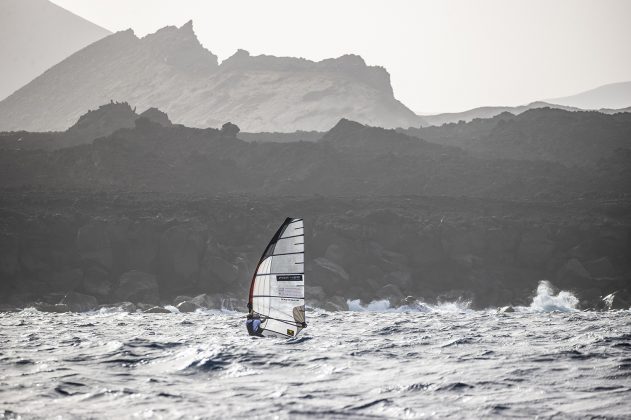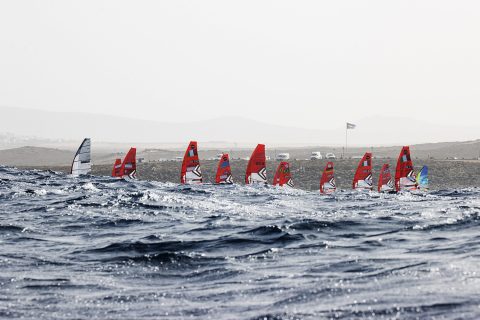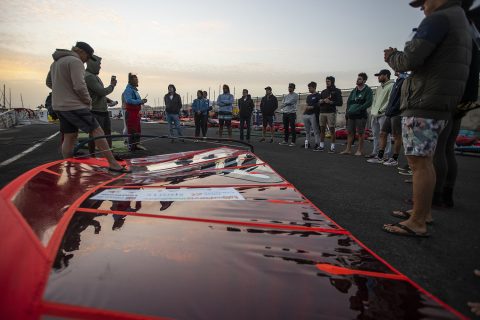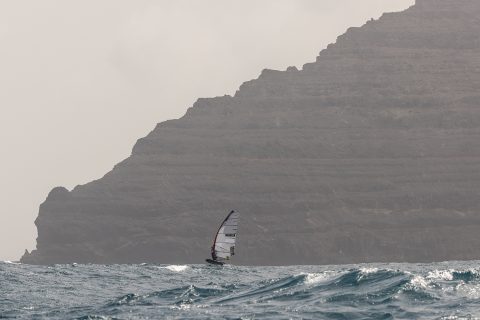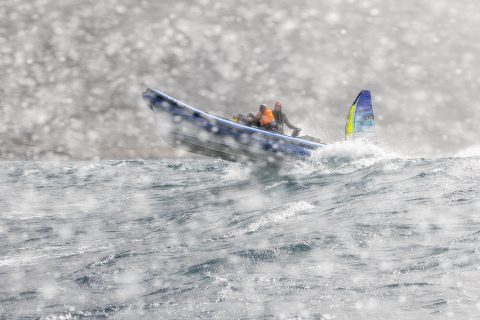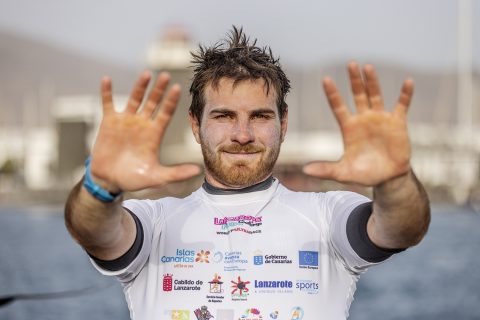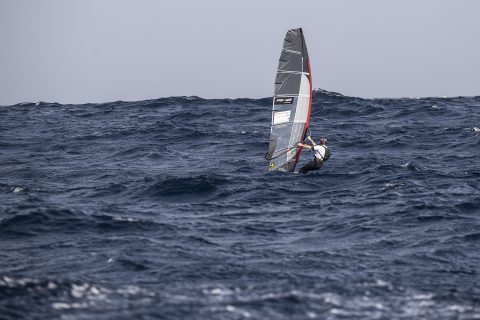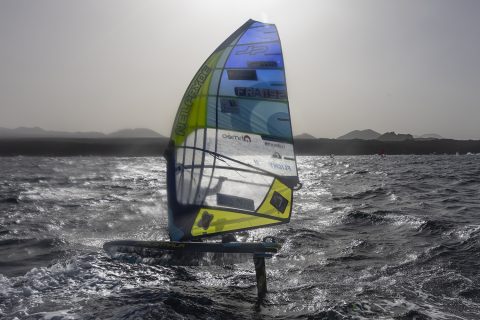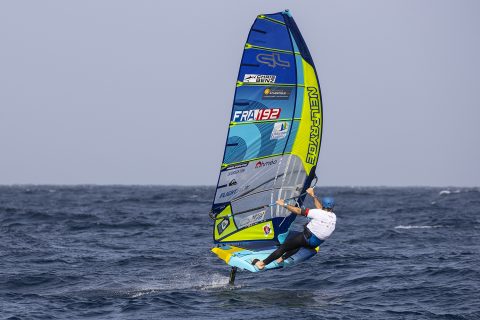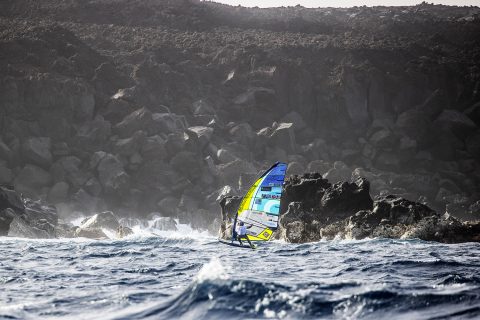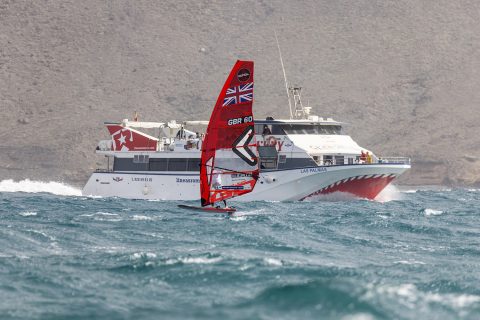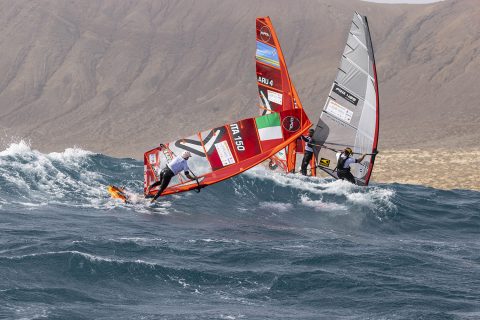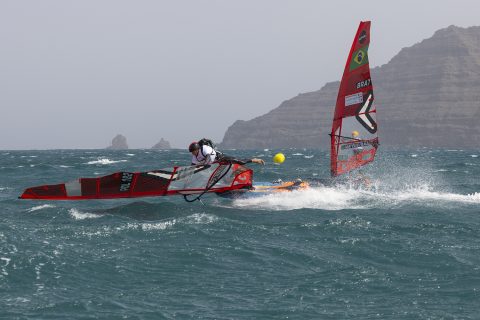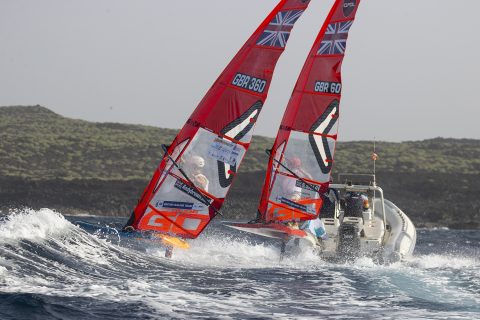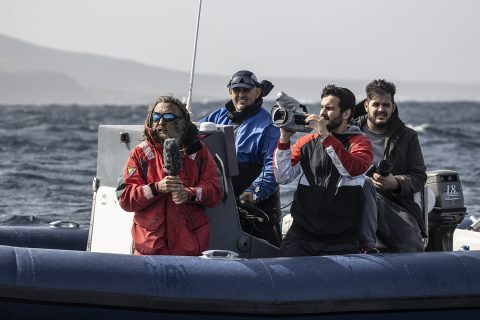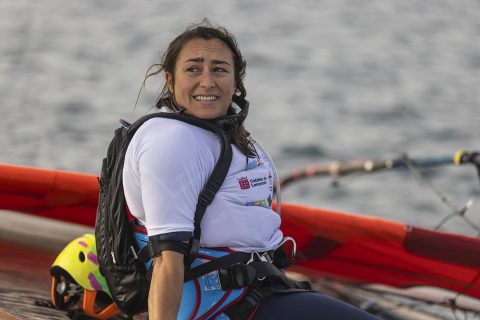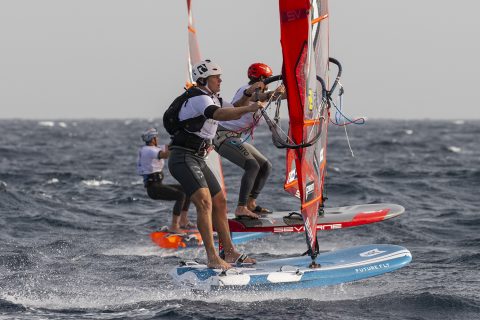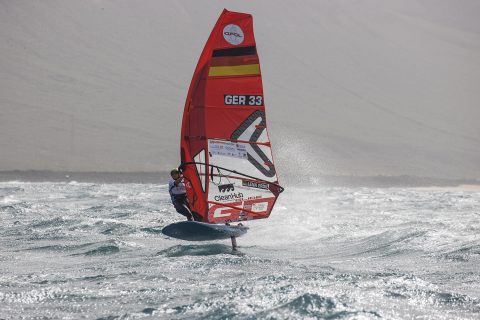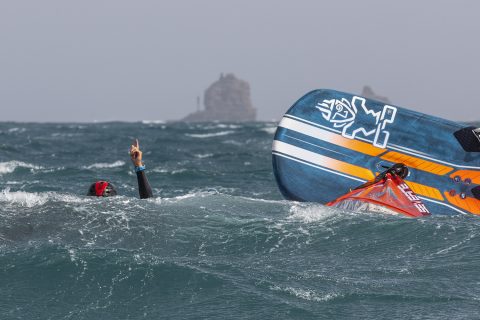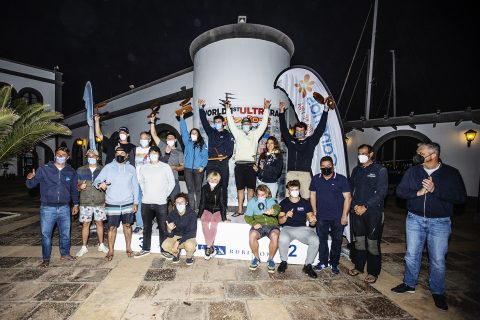LANZAROTE FOIL CHALLENGE 2022: GOING THE DISTANCE
Billed by the organisers as an ‘ultra-marathon’, the Lanzarote Foil Challenge saw competitors sail 200 kilometres around the island of Lanzarote. John Carter hit the high seas to capture the action and the racers tell us how they survived, going the distance!
Words: John Carter, Nico Goyard, Mateus Isaac, Antoine Albeau, Sam Sills, Andy Brown and Lena Erdil. // PHOTOS – John Carter.
JOHN CARTER
I received an invitation to the 2022 Lanzarote Foil Challenge just days before the event and from what I gathered it would be a pleasant trip round the island shooting some of the world’s elite foil racers taking on this daunting mission. I was promised awesome backdrops and amazing opportunities for photography, so I packed some basic waterproof apparel just in case of any adverse conditions and set off for the Canary Islands quite excited about rounding Lanzarote by boat.
- Race start
The format was for the sailors was to sail around the island with six planned pit stops to allow the tail-enders to catch up and allow a quick break to rest, eat and drink. All the sailors were armed with GPS trackers and were supported on the mission by eleven boats and five vans, who would pick up any sailors wishing to retire along the journey. The sailors carried backpacks containing water, energy gels and food, so they could stay ‘fuelled up’ whilst sailing. The distance around Lanzarote is around 200 km and the organizers were hoping to complete the challenge in around nine hours.
We set off from our hotel at dawn, ready to hit the water at 8 a.m. for the start of the event in Marina Rubicón. On the way, I was warned that the wind forecast was way stronger than anticipated and that we could be facing some wild seas. With 30-knot trades and a three-metre swell hammering in from the north, I soon realized that this journey was going to be far from pleasant. Going round the south of the island was not too bad, but once we started heading up the west coast towards La Graciosa, that is where things started to turn gnarly, and I realized I was totally unprepared for this wild journey. The seas up the west coast were rough with a short period swell that created a horrific standing chop and the boat was taking off as we ploughed into the surf. There was no way you could take any photos while the boat was moving as the spray was flying everywhere, as well as the boat being totally unstable.
- Skippers meeting
When we reached the north of the island after four hours of what I would call ‘hell’, conditions were even more difficult. By now we were in a big swell along with strong winds and this was definitely no place for the faint-hearted. A lot of the guys were saying once we were around the top of the island it would be ‘plain sailing’ back down the east coast, but in some ways, it was even worse flying down the waves in the boat close to the rocky shoreline. Somehow the foil guys made it round in those severe conditions, but even so, I have never seen the likes of Nico Goyard crash so many times during a race. Personally, it was a bit frustrating not being able to shoot everything I saw, but with the waves, spray and attempts at self-preservation, I was relieved to make it back to the port with my cameras still working! Fair play to Lena Erdil for making it all the way around, despite barely getting any time to rest as she was usually last to the checkpoints and many thanks to organizer Esteban Nieto for inviting me!
NICO GOYARD, FRA 465, 1st OPEN
Before the race I took time to double-check all my foil and wing connections, screws, boom, harness lines, etc. I wanted to be sure that nothing was going to break on the first crash! I also went with fellow French sailors, Lucas Guiraud, Antoine Albeau and Julien Bontemps, on a round the island trip by van to check the places where we were going to have some breaks. We also checked the different areas we would be sailing in to be able to know where we were heading while racing, and it was really beneficial to do that.
- Nico Goyard
SETTINGS
I kept my usual equipment settings for the upwind legs, but I modified my back wing angle and footstrap positions for the downwind legs to be more at ease. But in the end, I reduced too much my back wing angle and the first downwind section was a nightmare! I changed it again in Costa Teguise and then it was good! We had been busy training before the race for other events and I tuned my gear with Antoine Albeau and Julien Bontemps the week before, but in the end, we did not use the same gear for the race, as it was so windy. You can’t really prepare fully for a race like this, especially as the wind was much stronger on the day than they predicted. On one section near La Graciosa, I went into a lull, which was frustrating as I went too close to the cliffs and just got ‘stuck’ there for almost twelve minutes.
I used a 9.0 Phantom sail, 730 front wing and 250 back wing. I made a few mistakes on the downwind leg and fell many times. In Costa Teguise I broke two battens, so it made it hard on the last downwind leg where the wind was strong. My sail was like a balloon and in the gusts it was horrible.
- Rough seas the order of the day
EXPERIENCE
We had to stay not too far from the shore for safety reasons, so we had to tack quite often and in the end that was the main constraint leading us to tack or to continue on the same reach. I actually really loved this style of race; it was one of the best windsurfing experiences of my life! And what was really cool as well was the connection between all the riders and the way we were all checking how the others were feeling. It was more of a trip with friends than a race…. even though we were racing of course! The scenery was amazing and we had a big pod of dolphins chasing us downwind. I sailed more than eight hours in total, it was crazy. It was a bit too much wind, but if there was less wind it might have been really tricky.
- Nico Goyard
TIPS
My advice for anyone thinking of doing a race or long distance sail like this, is that a big mistake would be to take too small a sail or to try to have some too easy settings on the foil. Because then you lose all the power and you have to compensate so much, which leads to back pain way way quicker. Also, take care to ‘refuel’ regularly, eating and drinking at each break!
- Goyard out in the swells
I am thinking about designing a new board, which should be a bit more all-round and easy to use for this kind of trip. There are a lot of evolutions possible to make everything easier. Also, next time, I’ll make sure I know precisely the setting I want for the downwind leg!
MATEUS ISAAC, BRA 7, 1st iQFOiL MEN
I have been training a lot on the iQFOiL gear for my Olympic campaign and I decided to go on that gear. I used a little bit more downhaul than normal and had my harness lines a bit further back, which made it a bit more comfortable. There were fun moments, but overall it was painful and extremely challenging. We had a lot of wind and a lot of swell. It was tough.
There was one time just before we arrived in La Graciosa where it was so windy with close chop coming from all directions. It was blowing over thirty knots and I was just trying to get through that stage and make it to the end of the leg, but we also saw a lot of dolphins on the last downwind leg, which was amazing.
I used my 9.0 sail with a 900 front wing and 255 back wing and 115 fuselage. It was a lot to hold in thirty knots, but overall, the iQFOiL gear is very stable and easy to sail. I took a Camelbak with a lot of water, but as we approached the end of the race, I had drunk all my water and ate all my food and had no reserves for the last leg. Now it is finished, I can say I enjoyed it, but there were some points where I was wondering what I was I doing out there!
ANTOINE ALBEAU, FRA 192, 7th OPEN
- Antoine Albeau
I came to Lanzarote one week early to train with the guys. It was good training, but in the end, I did not use the gear I was training on. I decided to go with an 8.0 sail because it was windy in the morning, so I went a size smaller. But I just could not hold the sail and had a problem with my tuning.
- Antoine Albeau cruising
We knew we would be sailing for around nine hours. I think I sailed eight hours, forty minutes. We had a few stops where we were waiting, so we had a chance to rest. The last leg we did was almost one hour downwind. You could feel the fatigue by then!
- Antoine Albeau rock star
It was not like in slalom where you are pushing all the time on your back leg; on the foil there are a lot of positions you can use to relax your legs. When you go downwind you can depower the sail easily and you just need to glide. We were playing a lot going down the swells. It was an interesting race and you could see that everyone was fighting the elements. Between the island of La Graciosa and Lanzarote there was like three or four metres of swell. It was huge and very windy as well. It was definitely a challenge to sail in those conditions.
SAM SILLS, GBR 60, 9th OPEN
To prepare, I checked and replaced everything that looked suspicious or I hadn’t fully tested. The key to push for 9 hours is having confidence in your preparation. It would have been a major nightmare if anything broke. I tried to approach it like any other race, but I thought a little bit about the shifts and wind conditions we might face. I focused more on nutrition and had some expert help from nutritionist Nigel Mitchell and the British Sailing Team, which I’m really grateful for. The expected energy needed for the 200 km race was 4000-5000 calories, and I was drinking four gels an hour and eating a few bananas, as well as using hydration drinks.
- Sam Sills
I set the rig up so I could tune it over a wide wind range as we were expecting several different conditions, so longer boom settings to flatten the sail, easy to sail foil settings, adjustable lines, those kind of things. My main tactic was to have a clear start and keep my eyes out for the wind effects around the various volcanoes. However when we got to the tip of the island (the north shore section), it stopped being a race for me and my only goal was to finish, as any injury or equipment breakage would have been a big nightmare from that point onwards. As we got closer to the end it was ok to start pushing again. My tips would be to prepare your nutrition and equipment really well and prioritise comfort over speed; 9 hours is a long time to race!
I would say it was one of the most amazing windsurfing experiences of my life. It was an extreme endurance challenge and awesome to do it with that crew of amazing sailors. I crashed five times just getting to the start and almost turned round. You just had to take it step by step. When we got to the top of the island, I thought we were home and dry but the downwind leg was actually the hardest part. I have been training hard though over the last 12 months, so I knew I was in shape.
- Tough conditions
The hardest part was the top reach going from La Graciosa to Costa Teguise. The conditions were insane, strong wind, mast high waves and a huge backwash coming from the cliffs. That part was terrifying! It stopped being a race and it was more like survival. It was quite dangerous and all I wanted to do was finish.
- Over the handle bars
With guys like Nico and Antoine competing, it really felt like it was a high-profile event and that is part of the reason I wanted to do it. It was quite amazing because I was using a board I designed. I’ve been designing and developing foil racing boards with Severne over the last year and I decided to use one of the prototype 100 cm wide boards. I wanted to find the limits of the board, and put that learning into the development so I can improve the next version. It was a special experience to be able to use that board. I used a 9.0 as it was the sail, I knew the best and that is the sail I will use in my Olympic campaign. It was quite hard to handle, but I have done so many hours on that sail that it was ok.
My low point was the start because I felt stressed, but when we got into it, I could enjoy it a bit more. It was awesome when we arrived at La Graciosa with that blue water and the big cliffs of Lanzarote opposite us. It was beautiful out there and a highlight sailing in that scenery.
ANDY BROWN, GBR 360, 7th iQFOiL MEN
I used my iQFOiL equipment, it’s all I ever use, the main change was carrying 5 litres of carb filled water, which apart from limiting my ability to foil in the first leg was okay! My tactics were primarily to get through it! My time in the RS:X class was filled with back issues that plagued almost every competitor, so having never done anything like this and with the extra water pack I was slightly concerned. Thankfully I was pleasantly surprised by how well my body felt after the race. I was tired, very fatigued mentally and physically, but no damage. I was not even tired or hungry, which was strange, but I think I was past that point! But I certainly felt it the day after. I celebrated finishing at Lani’s Snack Bar in the marine with a fat ice cream!
- Brits abroad
During the race, I quickly realised that my upwind technique was rather energy intensive and was not maintainable over the hour plus long upwind legs, I adapted unfortunately at the expense of speed, but was very happy to make it round the island. It was a relief to finish and a huge challenge completed. It’s given me a new perspective of a hard days wind foiling… 6 race days will never compete with the hardship of the Lanzarote Foil Challenge! Dangerous moments were avoiding large turtles, fishing nets and buckets, but bar that nothing actually happened to me. Would I do it again anytime soon? Maybe not! Would I recommend doing it next year.. definitely. It was the most challenging day of my life.
- Media crew at work
Tips would be make sure you fuel well during the race. I had about 2000 calories of energy gels, which just about got me through it. Wear less and put on more if you need to. Sweating will kill you. You will be dehydrated after either way and very very dehydrated if you are also too hot or don’t drink salts.
LENA ERDIL, GER 33, 1st iQFOiL WOMEN
For tuning, I put my footstraps forward and other than that I changed the ropes on my booms so they were new and would not break. I went to bed super early the night before and had eight litres of rehydration water with me. I made sure I drunk every step of the way. I had a big breakfast in the morning with lots of oats. During the challenge I was eating energy bars and gels so I didn’t waste energy digesting anything heavier than that.
- Lena Erdil
I knew it could get challenging with that weather forecast. There were a few points where I was struggling because it was so windy. I felt I was in good physical shape for the race because I have been training for one year with my iQFOiL coach for my Olympic campaign.
- Downwind fun
I was sailing with my iQFOiL equipment because I thought it would be valuable for me to spend as much time on that gear as possible. I want that equipment to become a part of me. I wasn’t really sailing in my most efficient position though, I went for the maximum comfort position to survive and use the least amount of effort. So same equipment, but a different stance!
My tactics were to play the shoreline, especially on the upwind leg and I tried to stay as close as possible to the shore. That paid off quite well for me and I thought that was a good tactic. On the downwind leg it felt a bit flatter close to the shore also, but you had to avoid going into the wind holes.
- Good training for the Olympics!
The craziest moment was going from Famara to La Graciosa as the wind was so strong. I could not even close the sail anymore and was struggling to sail in a straight line. I dropped the sail a few times and there was a lot of water flying around and it was demanding work pulling it back up. When I arrived at the leg finish, I was last and everyone was waiting for me and they started the next leg straight away. The waves were looking huge and it was a tricky section. We thought we had the hardest part behind us. My coach, Olga Maslivets, had to give me a pep talk to tell me I could do it. When we left La Graciosa heading into that huge swell, I was a bit freaked out. I did not know how I was going to be able to reach the end when I could barely go upwind anymore. I had to trust my coach. There was not much room left for any doubt. I had to focus hard on keeping the board from crashing into the waves. I was at the point of no return and it felt like a dangerous moment. If you dropped your sail, it would be hard to find anyone out there. I could not see my support boat for a while and that was quite scary. The cliffs were huge and the waves were massive. I just had to make sure to keep going until I finally heard the motor of the boat again.
- Man down
After the race I was feeling emotional, exhausted and I was super happy that I made it and extremely proud. I felt almost shocked and scared after the race. I did not expect that this challenge was going to be such a fight against the elements. It was an emotional challenge as well as a physical challenge. I didn’t expect that my sailing skills in heavy conditions would be tested to new limits. I was thankful that I mastered it. I did the challenge also with my partner ‘CleanHub’ and they were going to collect 2.5 kg of ocean plastic for every kilometre I sailed. So with 200 kilometres completed, it would be half a tonne of rubbish cleaned up, that was a great motivation and made it extra important to finish.
We had a nice barbeque dinner after the race and then I just slept very well. I think you need to sail three to five hours a day on a regular basis to train for this sort of race. Also make sure you are using equipment that you are comfortable on and that it has a big wind range.
- All the winners


